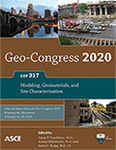Geo-Congress 2020
Application of Microtremor Horizontal to Vertical Spectra Ratio (MHVSR) and Multichannel Analysis of Surface Wave (MASW) for Shallow Bedrock Mapping for Transportation Projects
Publication: Geo-Congress 2020: Modeling, Geomaterials, and Site Characterization (GSP 317)
ABSTRACT
Mapping bedrock layers and their stiffness is an important part of geotechnical site characterization, particularly for highway projects that require significant rock excavation. A variety of invasive and non-invasive techniques can be used for this purpose. In this study, microtremor horizontal to vertical spectra ratio (MHVSR) and multichannel analysis of surface wave (MASW) methods were utilized along a proposed highway alignment, where the bedrock conditions are expected to be very shallow and highly variable. Two/three peaks were observed for the majority of the MHVSR measurements. The origin of the peaks was investigated using the proposed eye shape method in the literature and it was observed that an eye-shape spectral pattern is not always an accurate indicator of a peak with stratigraphic origin. MHVSR peaks in this study were determine to be of stratigraphy origin as they correspond well with the sharp impedance contrasts in the Vs profiles and subsurface layering from the boring logs. It seems that for cases of MHVSR with multiple peaks at very shallow bedrock sites, the peaks are reliable and they typically have a stratigraphy origin. This suggests that the MHVSR technique is a suitable non-destructive, rapid, and cost-effective alternative for traditional drilling and sampling for shallow bedrock mapping.
Get full access to this article
View all available purchase options and get full access to this chapter.
REFERENCES
Castellaro, S., & Mulargia, F. (2009). The effect of velocity inversions on H/V. Pure and Applied Geophysics, 166(4), 567-592. Caterpillar Inc (2000).
Coe, J., Brandenberg, S., Ahdi, S., & Kordjazi, A. (2018). Geophysical methods for determining the geotechnical engineering properties of earth materials. California department of transportation, Report Number CA-17-2111.
Cox, B. R., & Wood, C. M. (2011). Surface wave benchmarking exercise: methodologies, results, and uncertainties. In Geo-Risk 2011: Risk Assessment and Management (pp. 845-852).
Di Stefano, P., Luzio, D., Renda, P., Martorana, R., Capizzi, P., D'Alessandro, A.,... & Zarcone, G. (2014). Integration of HVSR measures and stratigraphic constraints for seismic microzonation studies: the case of Oliveri (ME). Natural Hazards and Earth System Sciences Discussions, 2(4), 2597-2637.
Deschenes, M. R., Wood, C. M., Wotherspoon, L. M., Bradley, B. A., & Thomson, E. (2018). Development of deep shear wave velocity profiles in the Canterbury Plains, New Zealand. Earthquake Spectra, 34(3), 1065-1089.
Konno, K., & Ohmachi, T. (1998). Ground-motion characteristics estimated from spectral ratio between horizontal and vertical components of microtremor. Bulletin of the Seismological Society of America, 88(1), 228-241.
Mohamed, A. M., El Ata, A. A., Azim, F. A., & Taha, M. A. (2013). Site-specific shear wave velocity investigation for geotechnical engineering applications using seismic refraction and 2D multi-channel analysis of surface waves. NRIAG Journal of Astronomy and Geophysics, 2(1), 88-101.
Pastén, C., Sáez, M., Ruiz, S., Leyton, F., Salomón, J., & Poli, P. (2016). Deep characterization of the Santiago Basin using HVSR and cross-correlation of ambient seismic noise. Engineering geology, 201, 57-66.
Rahimi, S., Wood, C. M., Bernhardt-Barry, M., & Himel, A. K. (2019, March). Updated Reference Shear Wave Velocity Curves for Near-Surface Site Characterization. In Geo-Congress 2019: Engineering Geology, Site Characterization, and Geophysics (pp. 324-333). Reston, VA: American Society of Civil Engineers.
Rahimi, S., Wood, C. M., Coker, F., Moody, T., Bernhardt-Barry, M., & Kouchaki, B. M. (2018). The combined use of MASW and resistivity surveys for levee assessment: A case study of the Melvin Price Reach of the Wood River Levee. Engineering Geology, 241, 11-24.
SESAME European Research Project. (2004). Guidelines for the implementation of the H/V spectral ratio technique on ambient vibration. Measurements, processing and interpretations. Project No. EVG1-CT-2000-00026.
Sirles, P. C. (2006). Use of geophysics for transportation projects (Vol. 357). Transportation Research Board.
Zywicki, D.J., Rix, G.J., 1999. Frequency-wavenumber analysis of passive surface waves. In: Symposium on the Application of Geophysics to Engineering and Environmental Problems 1999. Society of Exploration Geophysicists, pp. 75–84.
Information & Authors
Information
Published In
Geo-Congress 2020: Modeling, Geomaterials, and Site Characterization (GSP 317)
Pages: 622 - 632
Editors: James P. Hambleton, Ph.D., Northwestern University, Roman Makhnenko, Ph.D., University of Illinois at Urbana-Champaign, and Aaron S. Budge, Ph.D., Minnesota State University, Mankato
ISBN (Online): 978-0-7844-8280-3
Copyright
© 2020 American Society of Civil Engineers.
History
Published online: Feb 21, 2020
Published in print: Feb 21, 2020
ASCE Technical Topics:
- Analysis (by type)
- Bedrock
- Construction engineering
- Construction management
- Continuum mechanics
- Dynamics (solid mechanics)
- Engineering fundamentals
- Engineering mechanics
- Frequency analysis
- Geology
- Geomatics
- Geotechnical engineering
- Infrastructure
- Mapping
- Project management
- Rocks
- Solid mechanics
- Stiffening
- Structural behavior
- Structural engineering
- Surface waves
- Surveying methods
- Transportation engineering
- Transportation management
- Transportation studies
- Wave spectrum
- Waves (mechanics)
Authors
Metrics & Citations
Metrics
Citations
Download citation
If you have the appropriate software installed, you can download article citation data to the citation manager of your choice. Simply select your manager software from the list below and click Download.
